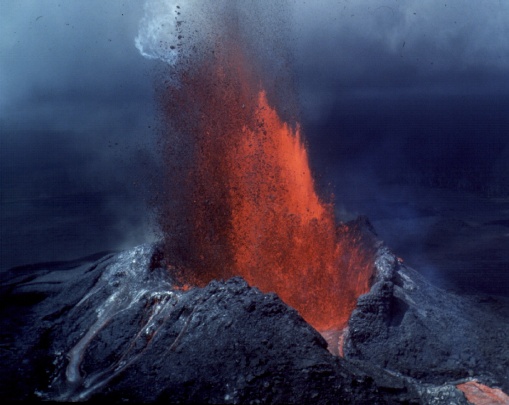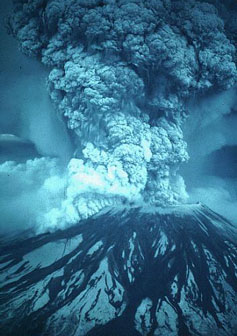Volcanic
Emissions & Global Cooling
The effect of
volcanic emissions on global climate has
been a hotly debated topic over the past few decades.
Below, we will take a look at the current arguments and science
relating to volcanic emissions and global cooling.
Table of Contents
I. Volcanic
Emissions
II. Carbon
Dioxide
III. Sulfur Dioxide
IV. Examples of Global
Cooling
V. Monitoring the Effects of Volcanoes
VI. Conclusion
VII.Sources Cited
Volcanic
Emissions
As
volcanoes erupt, they blast huge clouds into the atmosphere. These
clouds are made up of particles and gases that were previously trapped
in the geosphere, including sulfur dioxide, carbon dioxide, chlorine,
argon, carbon monoxide, and water vapor. Millions of tons of
harmful sulfur dioxide and carbon dioxide gas can reach the
stratosphere from a major volcano. While all these gases
play a small part in volcanic-induced climate change, carbon dioxide
and sulfur dioxide are by far the largest contributors to global
cooling.
Carbon Dioxide
Carbon dioxide emissions from volcanoes total around 110
million tons per year, but this number is extremely small if compared
to the 10
billion tons put into the atmosphere by human activities.
Despite being a greenhouse gas that is known
for its global warming potential, carbon dioxide, combined with
volcanic ash,
actually act as short-term coolants in the atmosphere by acting as a
“blanket”
that absorbs the sun’s radiation in the stratosphere before it can
reach the
earth’s surface. There are those who
argue that volcanic carbon dioxide emissions result in long-term global
warming, but the amounts released by volcanoes have not proven to be
substantial enough to significantly affect the global temperature in
the long
run.
Sulfur Dioxide
Sulfur dioxide has
the most adverse effect on the atmosphere of any of the volcanic gases. Sulfur dioxide is converted to sulfuric acid
within months of the eruption. Winds then
spread these newly formed aerosols over the majority of the globe,
where they
stay in the atmosphere for upwards of two years. Not
only do these aerosols cool the earth’s surface by reflecting
sunlight back into space, but the sulfuric acid also plays a role in
the
increased depletion of ozone (http://oea.larc.nasa.gov/PAIS/Aerosols.html).
Ozone is a natural absorbant of solar radiation, so when it is replaced
by reflective aerosols the total radiative energy in the atmosphere
decreases, resulting in global cooling. The following diagrams
illustrate this transformation of sulfur dioxide into the aerosols that
destroy ozone:
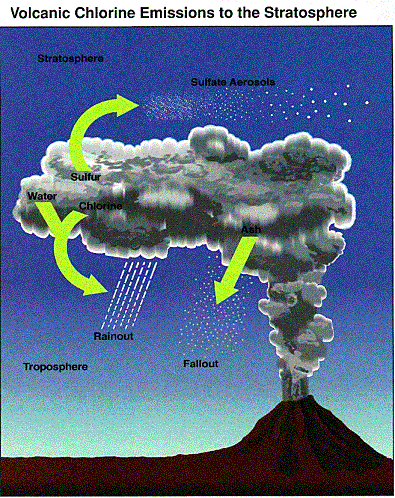
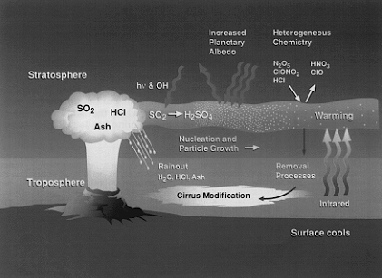
Examples of Global Cooling
One of the greatest
examples of
the global cooling caused by volcanic eruptions occurred in 1816, known
as “The
Year without a Summer” (http://itg1.meteor.wisc.edu/wxwise/museum/a5/a5volcan.html).
One year after Mount Tambora erupted in Indonesia its effects were
already
being felt globally. In New England
snow fell in July of 1816, with temperatures reaching the 30’s. Both
Europe and America faced economic
hardships as a result of premature frosts destroying large amounts of
crops. Some scientist also believe that the eruption of Mt. Toba
in Sumatra 73,500 years ago may have cooled the planet by 3-5 degrees
Celsius, resulting in a 'volcanic winter'.
The eruption of Mt. Pinatubo in
the Philippines in 1991 was one of the largest volcanic eruptions in
the past century. The injection of between 14-26 million tons of
sulfur into the stratosphere resulted in a global surface cooling of
0.5 degrees Celsius one year after the eruption. The short-term
climatic impact of this eruption was greater than El Nino or
human-induced greenhouse gas changes between 1991 and 1993.
The images below
illustrate the spreading of volcanic gases
during
the June 15, 1991 eruption of Mt. Pinatubo. These
satellite
observations demonstrate the enormous amounts of gas and ash emitted,
as well
as details such as differences in peak concentrations and geographic
extent. The one on the left shows sulfur
dioxide
concentrations, while the one on the right illustrates aerosol and
volcanic dust
concentrations.
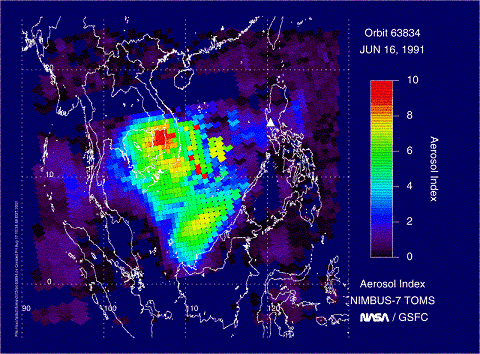
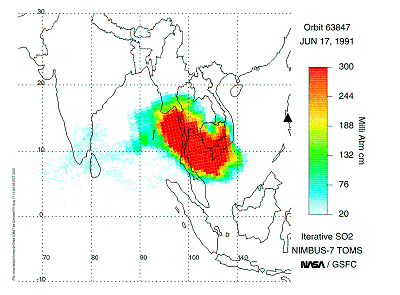
In most cases, however, volcanic
eruptions do not have such an extreme effect on the atmosphere. Eruptions
of the magnitude of Pinatubo only happen around once every 100
years. The overall impact of a volcanic eruption on
the atmosphere is dependent on the size of the volcano, its overall
emissions,
and the height of the volcano. No
substantial climate change due to a volcano, however, has ever been
witnessed
for more than 10 years after the initial eruption.
Monitoring the Effects of
Volcanoes
Measurements of the quantities of gases released by volcanoes is still
an educated guess at best. Human-led expedititions are nearly
impossible due to the dangerous nature of volcanic eruptions.
Even research planes can't collect accurate samples because they can't
fly high enough and it is simply too dangerous. Space observations
from NASA's Total Ozone Mapping Spectrometer (TOMS) instrument have
contributed significantly to our knowledge of the total amount of
greenhouse gases emitted into the atmosphere in the course of major
volcanic eruptions. Following the
eruption of Mount Pinatubo, TOMS images (above) showed sulfer-dioxide
spreading across the Pacific Ocean, and eventually covering the
globe. To date TOMS has been used to observe and record data on
over 100 volcanic events. (http://www.nasa.gov)
Conclusion
The magnitude of eruptions differ tremendously; they are unpredictable;
they differ in size; and ash and gases vary in composition. All
of these factors make it difficult for scientists to seperate volcanic
effects from other influences on the global climate. While
there is a definite short-term global cooling process brought about by
volcanic eruptions, there have been no noticeable long-term
effects, other than the depletion of ozone due to the release of
aerosols. The relatively small amount of
harm done to
the atmosphere by volcanoes cannot even compare to the extensive damage
done by
man.
